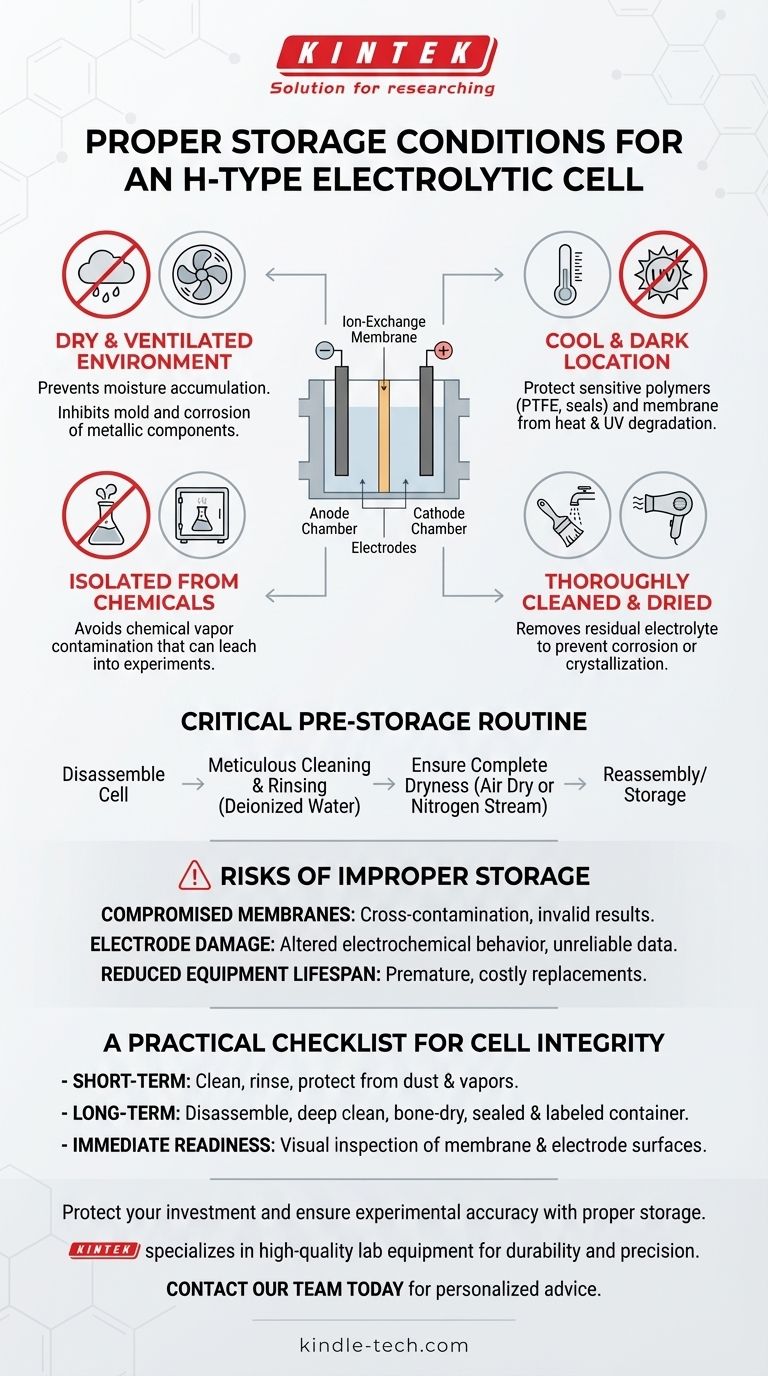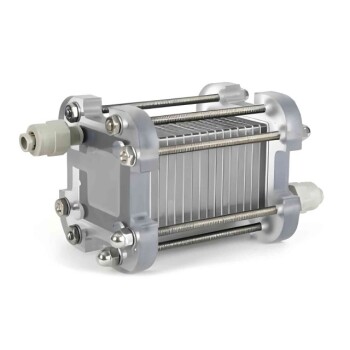Properly storing your H-type electrolytic cell is essential for preserving its integrity and ensuring the accuracy of your future experiments. The core requirements are to keep the cell in a dry, ventilated, and cool location, completely isolated from direct sunlight, high temperatures, and other chemical substances that could cause contamination or degradation.
The goal of proper storage is not just to prevent physical damage. It is a critical scientific practice designed to protect the sensitive components—especially the ion-exchange membrane and electrodes—from degradation and contamination, thereby guaranteeing the reliability and reproducibility of your results.

Why These Specific Conditions Matter
Simply following a checklist is not enough; understanding the rationale behind each step ensures you are actively protecting your equipment. Each condition prevents a specific type of damage that can compromise your cell's performance.
A Dry and Ventilated Environment
Lingering moisture is a primary cause of long-term damage. Storing the cell in a dry, well-ventilated area prevents moisture from accumulating on surfaces.
This is critical for inhibiting mold growth and preventing the corrosion of any metallic components, such as electrode connectors or clamps.
A Cool Location Away from Sunlight
Both heat and ultraviolet (UV) radiation from sunlight can accelerate the degradation of materials. Components made from polymers, like PTFE or sealing rings, can become brittle or lose their chemical resistance when exposed to these elements over time.
Most importantly, the ion-exchange membrane is particularly sensitive to heat and UV, which can damage its internal structure and alter its electrochemical properties.
Isolation from Other Chemicals
Laboratory environments are often filled with chemical vapors from various solvents and reagents. These vapors can adsorb onto the surfaces of your electrolytic cell.
This invisible contamination can later leach into your experiment, introducing unexpected variables and leading to inaccurate results or failed tests. Storing the cell in a dedicated, clean container or cabinet is a simple and effective solution.
The Critical Pre-Storage Routine
How you prepare the cell for storage is as important as the storage environment itself. A cell put away dirty will degrade regardless of where it is kept.
Thorough Cleaning and Rinsing
After each use, the cell must be completely disassembled and cleaned. All traces of electrolyte and reactants should be meticulously rinsed away, typically with deionized water.
This step prevents residual chemicals from slowly corrocoring surfaces or crystallizing within the cell's ports and chambers.
Ensuring Complete Dryness
Before reassembly or storage, every component must be perfectly dry. Trapped moisture can lead to the issues mentioned earlier, even in an otherwise dry storage location.
Air drying is often sufficient, but a gentle stream of nitrogen or clean, dry air can be used to speed up the process for complex parts.
Understanding the Risks of Improper Storage
Failure to adhere to these guidelines can lead to tangible and costly consequences that directly impact your research.
Compromised Ion-Exchange Membranes
The membrane is the heart of the H-type cell. If it is damaged by chemicals, heat, or allowed to dry out improperly, it can lead to cross-contamination between the anode and cathode chambers, rendering experimental results invalid.
Electrode Contamination or Damage
Electrodes with contaminated or corroded surfaces will exhibit altered electrochemical behavior. This leads to unreliable and non-reproducible data, as the electrode's performance will no longer be predictable.
Reduced Equipment Lifespan
An electrolytic cell is a precision instrument. Consistently poor storage practices will significantly shorten its usable life, leading to premature and costly replacement of membranes, seals, and electrodes.
A Practical Checklist for Cell Integrity
Use these guidelines to tailor your storage procedure to your specific timeline and needs.
- If your focus is short-term storage (between experiments): Ensure the cell is thoroughly cleaned, rinsed with deionized water, and protected from dust and lab vapors in a clean, covered area.
- If your focus is long-term storage (weeks or months): Disassemble the cell completely, clean each part meticulously, confirm everything is bone-dry, and store the components in a sealed, clearly labeled container in a dedicated cabinet.
- If your focus is immediate readiness: Before every use, perform a quick visual inspection of the membrane for tears or discoloration and check electrode surfaces for any signs of corrosion or fouling.
Following these storage principles ensures your equipment remains a reliable tool for generating accurate and reproducible data.
Summary Table:
| Storage Condition | Purpose | Risk of Neglect |
|---|---|---|
| Dry & Ventilated | Prevents moisture, mold, and corrosion. | Corrosion of metal parts and unreliable data. |
| Cool & Dark | Protects sensitive polymers and the ion-exchange membrane from heat/UV damage. | Brittle seals and altered membrane properties. |
| Isolated from Chemicals | Avoids vapor contamination that can leach into experiments. | Introduction of unknown variables and failed tests. |
| Thoroughly Cleaned & Dried | Removes residual electrolytes that can crystallize or corrode. | Internal damage and cross-contamination. |
Protect your investment and ensure experimental accuracy. Proper storage is key to maximizing the lifespan and performance of your lab equipment. KINTEK specializes in high-quality lab equipment and consumables, including electrolytic cells, designed for durability and precision. Let our experts help you maintain your equipment for reliable results. Contact our team today for personalized storage advice or to explore our range of reliable laboratory solutions.
Visual Guide

Related Products
- H Type Electrolytic Cell Triple Electrochemical Cell
- H-Type Double-Layer Optical Electrolytic Electrochemical Cell with Water Bath
- Electrolytic Electrochemical Cell with Five-Port
- Double Layer Five-Port Water Bath Electrolytic Electrochemical Cell
- Electrolytic Electrochemical Cell for Coating Evaluation
People Also Ask
- What are the standard opening specifications for an H-type exchangeable membrane electrolytic cell? Asymmetrical Ports for Precise Electrochemistry
- How should failures or malfunctions of an H-type electrolytic cell be handled? A Guide to Safe and Effective Troubleshooting
- What experimental conditions need to be controlled when using an H-type electrolytic cell? Ensure Reliable and Repeatable Results
- What preparation steps are needed before starting an experiment with an H-type electrolytic cell? A Guide to Safe and Accurate Results
- How should an H-type electrolytic cell be cleaned before use? Ensure Accurate Electrochemical Results



















